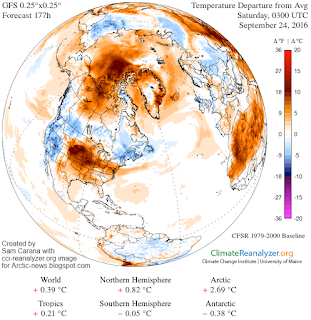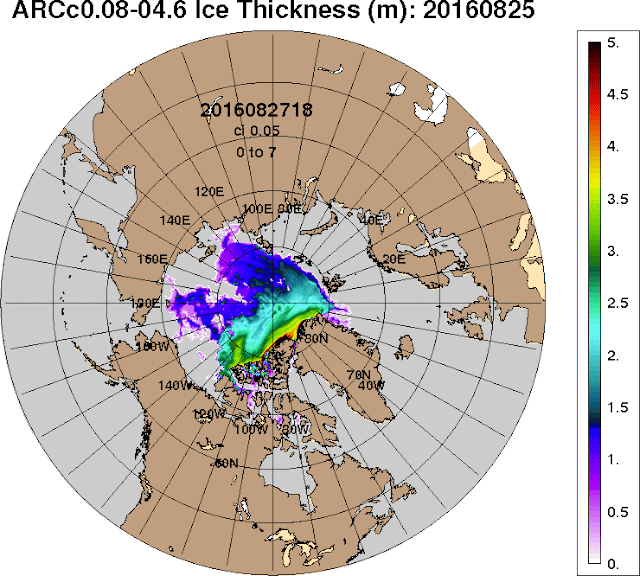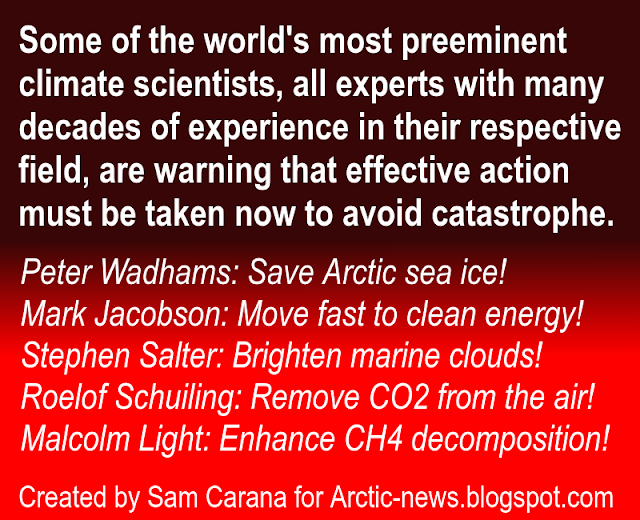 |
| [ click on images to enlarge ] |
Also note the purple line for 2010 on this image. In early September 2010, some people thought a low was reached (on September 12, 2010), but then a much lower extent was reached later (on September 21, 2010).
As the image below shows (screenshot from the Japan Aerospace Exploration Agency), 2016 Arctic sea ice extent (red line) has declined over the past two days.
Arctic sea ice extent may well decline further over the coming days. The image on the right shows a temperature anomaly forecast for September 24, 2016. This gives an idea of the temperature anomalies that can be expected over the Arctic Ocean over the upcoming week. Temperature anomalies over the Arctic as a whole will be above 2 degrees Celsius for almost that entire period.
There is scope for further sea ice decline, for a number of reasons [hat tip to Albert Kallio]:
- high air temperatures over the Arctic Ocean
- warm river water runoff
- high temperatures of the water in the Arctic Ocean
- very thin and fractured sea ice
- increased wave action of the ocean on sea ice
- increased vertical overturning of ocean water
- increased sea ice migration to absorb more heat from water
- increased sea ice transportation to the Atlantic Ocean / melt areas
- decreased snowline and albedo leading to higher insolation
- high and rising levels of greenhouse gases (CO2, CH4, N2O and water vapor) over the Arctic, trapping more heat
The video below shows that high temperatures are forecast over the Arctic Ocean over the upcoming week.
The time-lapse video below is based on NSIDC data and shows the age of sea ice in the Arctic from week to week since 1990, updated through the March 2016 winter maximum. The oldest ice (9 or more years old) is white. Seasonal ice is darkest blue. Old ice drifts out of the Arctic through the Fram Strait (east of Greenland), but in recent years, it has also been melting as it drifts into the southernmost waters of the Beaufort Sea (north of western Canada and Alaska).
The Naval Research Lab animation below show Arctic sea ice thickness over 30 days (up to September 16, 2016, with a forecast added up to September 23, 2016).
The Naval Research Lab sea ice speed and drift animation below over the same period shows that the amount of sea ice that is expected to move into Fram Strait is expected to increase over the next few days.
The image below shows that on September 24, 2016, it was as warm as 5.1°C or 41.1°F at a location where there still is some of the thicker Arctic sea ice left, with the inset showing Arctic sea ice on September 22, 2016.
The image below shows areas with some of the thicker sea ice on September 18, 2016.
The image below shows that sea surface temperatures on September 18, 2016, were much higher than they were in 1981-2000, especially at higher latitudes.
The image below shows September 18, 2016 sea surface temperature anomalies in the Arctic (latitudes 60°N - 90°N) compared to 1961-1990.

The danger is that, as temperatures of the water of the Arctic Ocean keep rising, heat will reach sediments at the bottom of the Arctic Ocean containing methane hydrates that are on the verge of destabilization. A small increase in temperatures could trigger huge abrupt release of methane from the seafloor of the Arctic Ocean.
The image below shows that on September 14, 2016, methane levels at 367 mb were as high as 2697 ppb and global mean methane level was as high as 1865 ppb.
The image below shows wildfires in Russia on September 18, 2016.
The image below shows that on September 18, 2016, these wildfires resulted in carbon monoxide levels as high as 24,309 ppb (top), and carbon dioxide levels as high as 612 ppm (bottom).

The situation is dire and calls for comprehensive and effective action, as described in the Climate Plan.
Links
• Arctic Sea Ice September 2016
http://arctic-news.blogspot.com/2016/09/arctic-sea-ice-september-2016.html
• Storms over Arctic Ocean
http://arctic-news.blogspot.com/2016/08/storms-over-arctic-ocean.html
• Wildfires in Russia's Far East
http://arctic-news.blogspot.com/2016/08/wildfires-in-russias-far-east.html
• Arctic Sea Ice Getting Terribly Thin
http://arctic-news.blogspot.com/2016/08/arctic-sea-ice-getting-terribly-thin.html
• High Methane Levels Follow Earthquake in Arctic Ocean
http://arctic-news.blogspot.com/2016/07/high-methane-levels-follow-earthquake-in-arctic-ocean.html


































